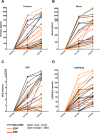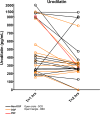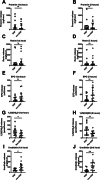(Pro)renin, Erythropoietin, Vitamin D and Urodilatin Release From Human Donor Kidneys During Normothermic Machine Perfusion: Predictors of Early Post-Transplant Outcome?
- PMID: 40278798
- PMCID: PMC12024645
- DOI: 10.1111/ctr.70163
(Pro)renin, Erythropoietin, Vitamin D and Urodilatin Release From Human Donor Kidneys During Normothermic Machine Perfusion: Predictors of Early Post-Transplant Outcome?
Abstract
Background: Human donor kidneys release (pro)renin, erythropoietin (EPO), active vitamin D, and urodilatin during normothermic machine perfusion (NMP). However, whether the endocrine function of donor kidneys is associated with post-transplant kidney function is unclear.
Methods: We studied 28 donor kidneys, including seven from donation after brain death (DBD) donors and 21 from donation after circulatory death (DCD) donors. Prior to transplantation, we measured levels of (pro)renin, EPO, 1,25(OH)2D in the perfusate, and urodilatin in urine during NMP. Hormone release rates were compared between kidneys with and without delayed graft function (DGF), and correlations were assessed between hormone release rates and donor characteristics and transplant outcome, including DGF duration, serum creatinine levels at 1-week post-transplant, and estimated glomerular filtration rate at 1-month post-transplant.
Results: DBD kidneys secreted significantly less EPO and more active vitamin D than DCD kidneys. Kidneys with DGF exhibited significantly higher release rates of active vitamin D and lower release rates of urodilatin compared to those without DGF. In addition, EPO release rate was positively correlated with serum creatinine levels at 1-week post-transplant. Finally, urodilatin release rates were negatively correlated with DGF duration and positively correlated with urine output.
Conclusions: Urodilatin release in urine and EPO and active vitamin D release in perfusate during NMP may serve as potential biomarkers for predicting early post-transplant outcomes.
Trial registration: ClinicalTrials.gov identifier: NCT04882254.
Keywords: donor kidney; early post‐transplant outcome; endocrine function; hormone release; normothermic machine perfusion.
© 2025 The Author(s). Clinical Transplantation published by Wiley Periodicals LLC.
Conflict of interest statement
The authors declare no conflicts of interest.
Figures






References
-
- Hosgood S. A., van Heurn E., and Nicholson M. L., “Normothermic Machine Perfusion of the Kidney: Better Conditioning and Repair?,” Transplant International 28, no. 6 (2015): 657–664. - PubMed
-
- Ravikumar R., Leuvenink H., and Friend P. J., “Normothermic Liver Preservation: A New Paradigm?,” Transplant International 28, no. 6 (2015): 690–699. - PubMed
Publication types
MeSH terms
Substances
Associated data
Grants and funding
LinkOut - more resources
Full Text Sources
Medical
Research Materials

